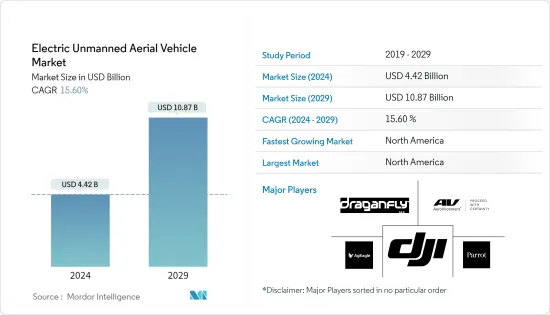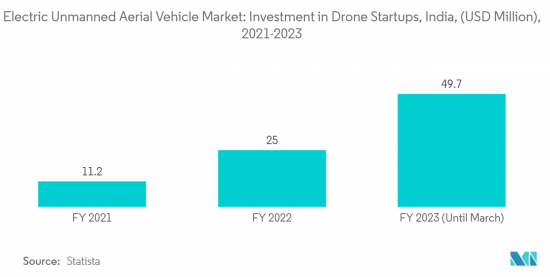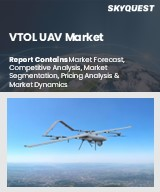
|
시장보고서
상품코드
1406231
전동 UAV(무인항공기) : 시장 점유율 분석, 산업 동향과 통계, 성장 예측(2024-2029년)Electric Unmanned Aerial Vehicle - Market Share Analysis, Industry Trends & Statistics, Growth Forecasts 2024 - 2029 |
||||||
전동 UAV(무인항공기) 시장 규모는 2024년에 44억 2,000만 달러로 추정되며, 2029년에는 108억 7,000만 달러에 달할 것으로 예측되며, 예측 기간 중(2024-2029년) CAGR로 15.60%의 성장이 예상됩니다.

주요 하이라이트
- 수년 동안 UAV 시장은 발전 단계에 있으며 상업 분야에서 더 많은 보급이 요구되고 있습니다. 처음에는 군용 장비로 여겨졌지만, 지난 5년 동안 드론은 상업 분야에서 큰 존재감을 드러냈습니다. 미국 연방항공청(FAA)과 유럽항공안전청(EASA)과 같은 관리 기관에서 몇 가지 새로운 적용 제외를 제공함에 따라 인프라, 농업, 운송, 엔터테인먼트, 보안, 보험 등 다양한 산업에서 UAV에 대한 수요가 증가하고 있습니다.
- UAV 비행 기술의 발전으로 제조업체들은 다양한 크기, 무게, 모양의 모델을 생산할 수 있게 되었으며, 다양한 센서 페이로드를 탑재할 수 있게 되었습니다. 또한 생산 비용 절감과 제조 효율성 향상을 위한 지속적인 노력으로 전기 UAV는 경제적으로 실행 가능한 제품이 되어 다양한 소비자를 끌어들일 수 있게 되었습니다.
- 가장 큰 제약은 기존 연료식 UAV에 비해 전기 UAV의 내구성이 제한적이라는 점입니다. 배터리 기술의 발전에도 불구하고 일부 용도는 더 긴 비행 시간이 필요하기 때문에 특정 시나리오에서 전기 UAV를 채택하는 데 어려움이 있으며, UAV와 관련된 안전 문제는 E-UAV 시장의 성장을 어느 정도 제한할 것으로 예상됩니다.
전동식 UAV 시장 동향
예측 기간 중 배터리 부문이 시장 점유율을 독식
- 배터리 기술은 탁월한 신뢰성과 성능으로 인해 전기 UAV 시장을 지배하고 있습니다. 배터리는 적응성과 범용성으로 인해 농업에서 인프라 검사에 이르기까지 다양한 UAV 용도에서 선호되는 전원으로 부상하고 있습니다. 충전소, 관리 시스템 등 배터리 기술을 지원하는 인프라가 잘 구축되어 있다는 점도 보급을 더욱 촉진하고 있습니다. 드론 산업에 대한 투자가 확대되면서 각 업체들은 연구개발을 강화하고 있으며, 특히 배터리 기술 강화에 힘을 쏟고 있습니다.
- 이러한 투자는 배터리 수명, 무게, 효율성과 같은 주요 과제를 해결하는 혁신을 촉진하여 배터리 구동 전기 UAV를 보다 현실적이고 경쟁력 있게 만들고 있습니다. 배터리 구동 드론의 채택을 촉진하는 배터리 관리 시스템(BMS)과 에너지 저장 솔루션의 발전을 목격하고 있습니다. 전기 UAV는 기존의 연료 구동 UAV에 대한 친환경적인 대안을 제공하기 때문에 이러한 추세는 지속가능성에 대한 전 세계의 광범위한 초점과 일치합니다.
- 마찬가지로, 배터리 재료와 전기화학의 지속적인 발전은 효율성, 무게 고려 사항 및 전반적인 성능의 최적 균형을 이루는 기술의 진화를 보장합니다. 이에 비해 태양광발전의 간헐적인 일조량과 연료전지 인프라의 한계와 같은 문제는 보급을 저해하고 있으며, 배터리가 UAV의 동력원으로서 업계 표준임을 강조하고 있습니다. 또한 태양전지 및 연료전지 대체품에 비해 배터리 기술의 현재 비용 효율성은 압도적인 시장 점유율에 기여하고 있으며, 배터리는 UAV에 전력을 공급하는 업계 표준이 되어 다양한 UAV 모델과 제조업체에서 더 높은 수준의 수용과 통합을 이끌어 내고 있습니다.
- 예를 들어 2022년 12월 패킷디지털은 미 해군에 무인항공기 시스템(UAS)의 스마트 배터리, 충전기, 전원 시스템을 공급하는 850만 달러 규모의 계약을 체결했습니다. 이 계약에 따라 패킷디지털은 해군의 차세대 해상 물류 UAS를 위한 고성능 UAS 배터리 시스템 설계 및 제조를 담당하게 됩니다.

예측 기간 중 북미가 시장을 장악
- 미국과 같은 국가는 국경이 매우 넓기 때문에 순찰대가 도달할 수 없는 지역을 지속적으로 커버하기 위해 UAV를 배치할 필요가 있습니다. 이러한 필요성으로 인해 미국 국경 수비대의 운영 요구 사항을 충족하기 위해 내구성이 강화되고 운영 비용이 낮은 E-UAV에 대한 수요가 증가하고 있습니다. 또한 군 및 국방 분야에서 전술 UAV가 크게 배치되면서 소형 UAV의 조달이 증가하고 있습니다. 소형 UAS는 어떤 유형의 전력 시스템으로 구동되기 때문에 조달률 증가는 이 지역의 E-UAV 시장을 촉진할 것으로 보입니다.
- 미군과 그 파트너는 적진이나 외딴 지역에 있는 부대에 대한 보급과 같은 물류 임무를 포함하여 드론 운영의 범위를 확장하고 있습니다. 고유한 설계 기능은 UAV의 대체 용도에 힘을 실어주고 있습니다. 미국 국방부(DoD)와 미 항공우주국(NASA)은 기존 추진 시스템을 대체할 군용 UAV용 첨단 엔진 및 관련 부품의 연구개발에 많은 투자를 하고 있습니다. 다양한 고객층에 대응하기 위해 수많은 계약이 체결되고 있습니다.
- 예를 들어 2023년 7월 미국 국방고등연구계획국(DARPA) 전술기술국은 ANCILLARY 프로그램에 따라 노스롭그루먼(Northrop Grumman)에 자율 수직이착륙(VTOL) 무인항공기 개발 계약을 발주했습니다. 이 무인 항공기는 덕트형 팬을 구동하는 전기 모터와 배터리가 장착된 하이브리드 전기 전원을 탑재할 예정입니다.
전동 UAV 산업 개요
전동 UAV 시장은 단편화되어 있으며, 많은 활동적인 기업으로 구성되어 있습니다. 유명 기업으로는 AeroVironment, Inc., AgEagle Aerial Systems Inc., SZ DJI Technology, Parrot Drones SAS, Draganfly Inc. 등이 있습니다. 일반적인 경제 상황은 주로 미국 및 유럽과 같은 지배적 인 시장에서 UAV와 같은 기술 기반 플랫폼의 판매에 영향을 미칩니다. 따라서 경기 침체기에는 구매가 연기되거나 취소될 수 있으며, 상대적으로 채택률이 감소하여 시장 역학에 부정적인 영향을 미칠 수 있습니다. 제품 라인업을 강화하기 위해 지속적으로 투자하고 있습니다.
시장 기업은 UAV의 기술적 숙련도를 활용하고 빠르게 발전하는 E-UAV 시장의 상업 부문에 대한 침투를 강화하기 위해 많은 자원과 노력을 기울일 의향이 있습니다. 제품 제공과 연계된 시장 다각화는 장기적으로 수익성과 생존을 보장하는 중요한 기준이 될 것으로 보입니다.
기타 특전 :
- 엑셀 형식의 시장 예측(ME) 시트
- 3개월간의 애널리스트 지원
목차
제1장 서론
- 조사의 전제조건
- 조사 범위
제2장 조사 방법
제3장 주요 요약
제4장 시장 역학
- 시장 개요
- 시장 촉진요인
- 시장 억제요인
- Porter's Five Forces 분석
- 구매자/소비자의 교섭력
- 공급 기업의 교섭력
- 신규 진출업체의 위협
- 대체품의 위협
- 경쟁 기업간 경쟁 강도
제5장 시장 세분화
- 기술
- 배터리
- 솔라
- 연료전지
- 지역
- 북미
- 미국
- 캐나다
- 유럽
- 영국
- 프랑스
- 독일
- 러시아
- 기타 유럽
- 아시아태평양
- 중국
- 인도
- 일본
- 한국
- 호주
- 기타 아시아태평양
- 라틴아메리카
- 브라질
- 멕시코
- 기타 라틴아메리카
- 중동 및 아프리카
- 사우디아라비아
- 아랍에미리트
- 남아프리카공화국
- 기타 중동 및 아프리카
- 북미
제6장 경쟁 구도
- 벤더 시장 점유율
- 기업 개요
- Aeronautics Ltd.
- AeroVironment, Inc.
- AgEagle Aerial Systems Inc.
- Parrot Drones SAS
- Draganfly Inc.
- SZ DJI Technology Co., Ltd.
- Bye Aerospace
- Elbit Systems Ltd.
- Teledyne FLIR LLC
- VAYU Aerospace
- Airbus SE
- Intel Corporation
- Lockheed Martin Corporation
- RTX Corporation
- Sunlight Aerospace
제7장 시장 기회와 향후 동향
KSA 24.01.23
The Electric Unmanned Aerial Vehicle Market size is estimated at USD 4.42 billion in 2024, and is expected to reach USD 10.87 billion by 2029, growing at a CAGR of 15.60% during the forecast period (2024-2029).
Key Highlights
- For several years, the umanned aerial vehicle (UAV) market has been in the developing phase, facing a need for more adoption in the commercial sector. Although they were initially viewed as military devices, drones have established a significant presence in the commercial sector over the past five years. Over the years, with several new exemptions from governing bodies like the FAA and EASA, the demand for UAVs has emerged from various industries, like infrastructure, agriculture, transport, entertainment, security, and insurance.
- Advancements in UAV flight technologies have allowed manufacturers to produce a wide range of models in different sizes, weights, and shapes, which can carry different sensor payloads, making them favorable across a broad application base. Moreover, Ongoing efforts to reduce production costs and enhance manufacturing efficiency make electric UAVs more economically viable, attracting a broader range of consumers.
- One significant restraint is the limited endurance of electric UAVs compared to traditional fuel-powered counterparts. Despite advancements in battery technology, some applications require longer flight durations, posing challenges for electric UAV adoption in certain scenarios. Associated safety concerns with UAVs are anticipated to further restrict the growth of the E-UAV market to a certain extent.
Electric Unmanned Aerial Vehicle Market Trends
Battery Segment to Dominate Market Share During the Forecast Period
- The electric UAV market is dominated by battery technology, owing to its unparalleled reliability and proven track record. Batteries, with their adaptability and versatility, emerge as the preferred power source across diverse UAV applications, from agriculture to infrastructure inspection. The well-established infrastructure supporting battery technology, including charging stations and management systems, further propels its widespread adoption. With growing investment in the drone industry, companies are intensifying R&D, particularly in enhancing battery technologies.
- These investments are fostering innovations to address key challenges such as battery life, weight, and efficiency, thereby making battery-powered electric UAVs more viable and competitive. The UAV industry is witnessing advancements in Battery Management Systems (BMS) and energy storage solutions, propelling the adoption of battery-powered drones. This trend aligns with the broader global focus on sustainability, as electric UAVs offer environmentally friendly alternatives to traditional fuel-powered counterparts.
- Similarly, continuous advancements in battery materials and electrochemistry ensure an evolving technology that strikes an optimal balance between efficiency, weight considerations, and overall performance. In comparison, challenges like intermittent sunlight for solar power and infrastructure limitations for fuel cells hinder their widespread implementation, emphasizing the entrenched position of batteries as the industry standard for powering UAVs. Moreover, the current cost-effectiveness of battery technology compared to solar and fuel cell alternatives contributes to its dominant market share, and batteries have become the industry standard for powering UAVs, leading to a higher level of acceptance and integration across different UAV models and manufacturers.
- For instance, in December 2022, Packet Digital was awarded a USD 8.5 million contract to supply unmanned aircraft systems (UAS) smart batteries, chargers, and power systems for the US Navy. As per the contract, Packet Digital was responsible for designing and manufacturing high-performance UAS battery systems for the next generation of Navy Maritime Logistics UAS.

North America to Dominate the Market During the Forecast Period
- The vast expanse of geographic national borders of countries such as the US necessitates the deployment of UAVs to ensure continuous coverage in the regions that are unreachable by patrol forces. The need has resulted in a subsequent increase in demand for E-UAVs with enhanced endurance and lower operational costs to fulfill the operational requirements of the US border patrol forces. Furthermore, the significant deployment of tactical UAVs in military and defense applications has resulted in increased procurement of small UAVs. Since small UAS are powered by some electric power system, the augmented procurement rate would drive the E-UAV market in the region.
- The US military and its partners are widening their scope of drone operations to include logistics missions such as resupply to forces in enemy territories or remote locations. Unique design features are empowering alternative uses for UAVs. The US Department of Defense (DoD) and the National Aeronautics and Space Administration (NASA) are investing heavily in the R&D of advanced engines and associative components for military UAVs, which will replace the existing propulsion systems. The growing demand for UAVs has resulted in the emergence of several business opportunities in the region, and numerous contracts are being handed out to cater to the broad clientele.
- For instance, In July 2023, Under the ANCILLARY program, the US Defense Advanced Research Project Agency's (DARPA) Tactical Technology Office awarded Northrop Grumman Corporation a contract to develop an autonomous vertical takeoff and landing (VTOL) uncrewed aircraft. The UAV will have electric motors powering ducted fans and a hybrid-electric power source with batteries.
Electric Unmanned Aerial Vehicle Industry Overview
The electric unmanned aerial vehicle market is fragmented and consists of many active players. Some of the prominent ones are AeroVironment, Inc., AgEagle Aerial Systems Inc., SZ DJI Technology Co., Ltd., Parrot Drones SAS, and Draganfly Inc. The prevalent economic situations primarily influence the sales of technology-based platforms such as UAVs in dominant markets such as the United States and Europe. Hence, in periods of economic downturn, purchases may be subjected to deferral or cancellation and a relatively slower rate of adoption, which, in turn, can adversely affect the market dynamics. Product innovation is a primary focus in the E-UAV market and associative component vendors are continuously investing in R&D activities to enhance their product offering.
The market players intend to devote significant resources and efforts to capitalizing on the technological proficiency of UAVs and enhance their penetration into the rapidly evolving commercial segment of the E-UAV market. Diversification of geographical markets, in tandem with the product offerings, would be a key criterion for ensuring profitability and survival in the long run.
In September 2023, Teal Drones signed a USD 1.8 million contract with the US Customs and Border Protection to provide Teal 2 systems to US Border Patrol. Teal drones will deliver 106 Teal 2 drones plus spare parts and training. The US Border Patrol is using the Teal 2 drone to provide situational awareness for US field commanders and agents. Teal Drone has partnered with ESAero for a multi-battery charger, which will be offered as an accessory with the Teal 2 drones. ESAero's multi-battery charger will make it possible to charge backup batteries while the UAV is in operation to support persistent ISR missions.
Additional Benefits:
- The market estimate (ME) sheet in Excel format
- 3 months of analyst support
TABLE OF CONTENTS
1 INTRODUCTION
- 1.1 Study Assumptions
- 1.2 Scope of the Study
2 RESEARCH METHODOLOGY
3 EXECUTIVE SUMMARY
4 MARKET DYNAMICS
- 4.1 Market Overview
- 4.2 Market Drivers
- 4.3 Market Restraints
- 4.4 Porter's Five Forces Analysis
- 4.4.1 Bargaining Power of Buyers/Consumers
- 4.4.2 Bargaining Power of Suppliers
- 4.4.3 Threat of New Entrants
- 4.4.4 Threat of Substitute Products
- 4.4.5 Intensity of Competitive Rivalry
5 MARKET SEGMENTATION
- 5.1 Technology
- 5.1.1 Battery
- 5.1.2 Solar
- 5.1.3 Fuel-Cell
- 5.2 Geography
- 5.2.1 North America
- 5.2.1.1 United States
- 5.2.1.2 Canada
- 5.2.2 Europe
- 5.2.2.1 United Kingdom
- 5.2.2.2 France
- 5.2.2.3 Germany
- 5.2.2.4 Russia
- 5.2.2.5 Rest of Europe
- 5.2.3 Asia-Pacific
- 5.2.3.1 China
- 5.2.3.2 India
- 5.2.3.3 Japan
- 5.2.3.4 South Korea
- 5.2.3.5 Australia
- 5.2.3.6 Rest of Asia-Pacific
- 5.2.4 Latin America
- 5.2.4.1 Brazil
- 5.2.4.2 Mexico
- 5.2.4.3 Rest of Latin America
- 5.2.5 Middle-East and Africa
- 5.2.5.1 Saudi Arabia
- 5.2.5.2 United Arab Emirates
- 5.2.5.3 South Africa
- 5.2.5.4 Rest of Middle-East and Africa
- 5.2.1 North America
6 COMPETITIVE LANDSCAPE
- 6.1 Vendor Market Share
- 6.2 Company Profiles
- 6.2.1 Aeronautics Ltd.
- 6.2.2 AeroVironment, Inc.
- 6.2.3 AgEagle Aerial Systems Inc.
- 6.2.4 Parrot Drones SAS
- 6.2.5 Draganfly Inc.
- 6.2.6 SZ DJI Technology Co., Ltd.
- 6.2.7 Bye Aerospace
- 6.2.8 Elbit Systems Ltd.
- 6.2.9 Teledyne FLIR LLC
- 6.2.10 VAYU Aerospace
- 6.2.11 Airbus SE
- 6.2.12 Intel Corporation
- 6.2.13 Lockheed Martin Corporation
- 6.2.14 RTX Corporation
- 6.2.15 Sunlight Aerospace

















